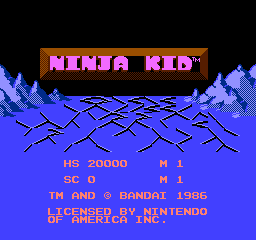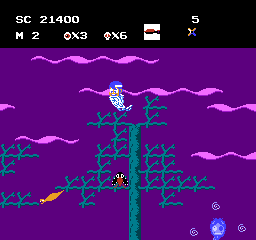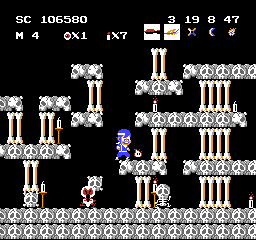Year: 1986
Publisher: Bandai
Genre: Platformer
Before I do a review of a game with “ninja” in the title, I just want to clear the air. I’ve already been pretty critical about a martial arts title for the NES, so let me just state the following: ninjas are awesome, especially in video games. Having said that, the 80’s were a different time. You know how everything is about zombies now, and how for every excellent zombie movie or game, there are about three hundred utterly forgettable crap movies and games that no one will ever watch or play a second time on purpose? That’s how ninjas were in the 80’s. What I’m really trying to say is, when I came to this game, I knew I had played it before, but simply could not remember which ninja game it had been.

Having thus explained why I don’t immediately fall into drooling nerdgasms nor debates about pirates whenever ninjas are mentioned, let me say that Ninja Kid is not by any means the worst ninja game available for the NES. Believe you me, there are some pretty foul ninja games out there. It is, however, not particularly memorable, and with a plethora of ninja games to pick from, you really need to stand out to earn your place in the annals of the meta-subgenre.

In Ninja Kid, you take the role of a kid who is a ninja. (Shocking, I know.) You have a number of the pretty basic ninja abilities – the ability to throw things (little kunai knives at first, but you can acquire powerups like shurikens, boomerangs, fireballs and what I can only assume are sandwiches), the ability to run in an absurd posture, the ability to jump a vertical distance greater than your height (although, let’s face it, every Nintendo character that can jump has that power) and the ability to ride a tornado like Pecos Bill (the great Texan ninja). Pretty much all the stock ninja powers are represented except for stealth and the ability to climb walls (which don’t seem to exist in this world).
The game begins each world with an overhead map with a number of towers and other more inconsequential landmarks on it. On some of the game’s maps, you can’t very well avoid any of the towers, but on others you can choose between them. The towers have a slightly different appearance which, as far as I can tell, determines which boss you might face at the end of the level, but what level you actually play is a game of Schrodinger’s Roulette*, so picking and choosing towers seems to be an exercise in futility.

Each time you enter a level, you are transported to one of a number of action sequences, each with different name and goals. In Guerrilla Warfare, for example, you have to kill enemy ninjas, whereas in Poison Field, you have to collect souls, and in Blazing Inferno, you have to use a little flame that follows you around erratically to light candles. Eventually, if you do whatever thing your level requires you to do enough, a key appears and you get to choose one of two doors to leave through, giving you a 50% chance of having to fight a mini boss or leaving to the map screen free and clear. The mini bosses themselves aren’t really that difficult, but don’t give you any sort of non-score-based reward either (and really, who pays any attention to points?).
At the end of each world, you face down a boss in a “Challenge of Shangri-La” battle (their words, not mine). The bosses are, generally, laughably easy if you saved any shurikens or fireballs for them, and Nintendo Hard if you’re taking them on with your stock kunai knives. Once you beat the boss, you muddle through the whole mess again. Lather, rinse, repeat. Kobayashi Mario**.
John’s Rating: 2.5 out of 5.0. Generally, this game isn’t so bad, and I can waste, perhaps, a few hours playing it, but it really doesn’t have much going for it either. The gameplay is mediocre and generally dull, the graphics are sometimes confusing and unmemorable, and the music is repetitive and boring. This game isn’t so much bad as disappointing – you come away from the experience feeling like they could have done more with it but didn’t.
* Schrodinger’s Roulette: A situation wherein the outcome of a decision is determined only when you make the decision. Normally, this phenomenon is impossible to distinguish from a pregenerated effect, but players with access to some method of saving states or rewinding gameplay may be able to take advantage of such a process to consistently achieve the outcome of their choice.
I think that those might be blow darts.
What? The tasty sandwiches? Who wants to eat blow darts?